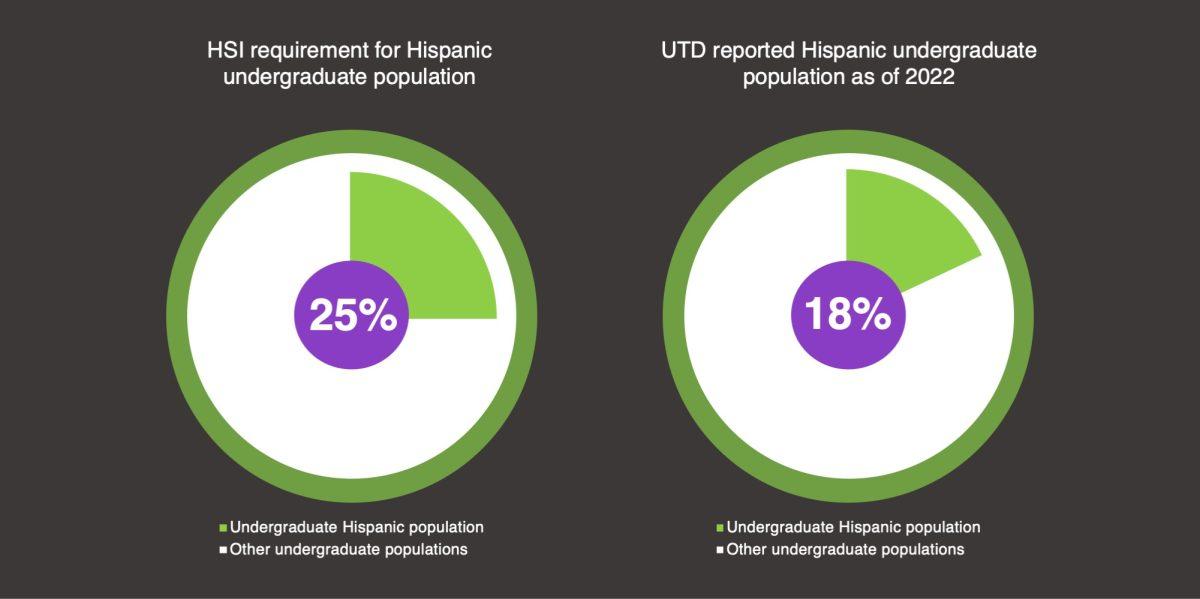UTD is in the process of becoming a Hispanic-Serving Institution, meaning it is aiming to have a 25% Hispanic or Latino undergraduate population.
Based on the Higher Education Act of 1965, a Hispanic-Serving Institution is a university that qualifies for additional federal funding if it meets five criteria, including the 25% Hispanic quota. This federal designation would provide access to special heritage language programs for Spanish speakers as well as increased financial aid from the federal government; it could also attract talented Latino applicants and enrich current student experiences. Student officers in the League of United Latino American Citizens, or LULAC, said they support the conversion and believe it will increase access to higher education for those in the Dallas area.
According to the Office of Institutional Success and Decision Support, while UTD’s Hispanic population was only 18% in fall 2022, it meets all the other guidelines, including being an accredited public university. As the Supreme Court recently struck down Affirmative Action and DEI offices will become illegal in Texas in January, questions remain on how UTD will fit this guideline. However, Melissa Hernández-Katz, director of equity policy education, said that becoming an HSI was an institutional goal for UTD even before the DEI ban and is not limited to just the Office of Diversity, Equity, and Inclusion.
“Obviously increasing the numbers is part of that, but there are other things that we have to do as part of that application as well,” Hernández-Katz said. “The student equity initiative, that’s what they’re going after.”
Psychology senior Nathalia Patricio and Latin American studies senior Ginny Mendez are, respectively, president and vice president of LULAC, an organization that focuses on advocacy, volunteering and fundraising to support Latinos. They said that the designation of Hispanic-Serving Institution will likely help connect Hispanic and Latino students in the Dallas area.
“Dallas is a big city with a large Latino population; I think, long-term, [HSI] would also help out the city,” Mendez said. “Maybe within 20 to 25 years, I’m excited to see our community flourish.”
The Mercury conducted a poll of 17 students on their thoughts of UTD’s HIS status goal. Out of the 14 respondents who identified as Latino, 100% said they felt they were treated no different than other students. Seven students completed the full survey, of which six indicated that they felt somewhat or definitely isolated at UTD.
“I feel like no one really sees us … me as a Latina, I feel like I’m just there,” a respondent said. “All other cultures are represented and Hispanics are just there. During [the homecoming] parade, all flags were represented except Mexico.”
UTD officials said that obtaining HSI status opens the door for the university to seek federal grants targeted to specific eligible institutions; however, these grants are not automatically awarded and require an application process. Hernández-Katz said that UTD remains unaffected by the recent Supreme Court ruling on affirmative action, as the university’s admissions process remains race-neutral. Additionally, it is important to note that the HSI conversion project extends beyond the Office of Diversity, Equity, and Inclusion, making it an ongoing institutional priority. Patricio said she supports the motives behind the conversion.
“Dallas is a very big city and there is a lot of Hispanics, and especially in Dallas… I know that I was surrounded by a lot of Hispanics and then suddenly I’m not. So, I think becoming a Hispanic Serving Institute will help students be able to find themselves a little bit more,” Patricio said.
If UTD becomes an HSI, it will likely be invited to join the Hispanic Association of Colleges and Universities, which represented 508 universities in 2022. It will begin receiving federal grant funding to improve institutional programs, facilities and services that expand the educational opportunities for Hispanic Americans. This will help promote graduations and ideally help students move into UTD’s graduate school, which has only a 2.80% Hispanic population. According to UNIVSTATS, the graduation rate for Hispanic people is 66.5% whereas the non-Hispanic average graduation rate is 70%.
“Having an HSI designation will expand the number of grants for which we, as an institution, are eligible to apply,” UTD officials said.





